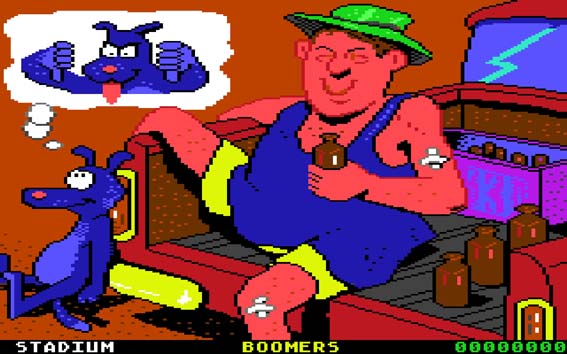This article is part of a collaboration with iQ by Intel.
The Play It Again project preserves Australian games from the 1980s, one of the most creative and bizarre times for designers in the country. A collaboration between several universities and museum partners, the Play it Again project seeks to digitally preserve—and in the process, reintroduce—Australia’s illustrious videogame history. By making these great Australian games more widely accessible, the project reminds audiences of just how big a hand the country had in shaping game design during the era of power-suits and synthesizers.
“We want to save Australia’s important screen history, and we want to remind Australians that we had a very early games development industry, and it produced some extraordinary games in the 1980s,” said Helen Stuckey, who works in tandem with Flinders University leader Melanie Salwell on the project. “They were pioneering games,” Stuckey said about Australian developers of that time. “We have The Way of the Exploding Fist (1985) and The Hobbit (1982). The Hobbit was one of the earliest licensed games that we’re aware of. The book was even packaged with it. Exploding Fist was one of the earliest fighting simulations for the home computer.”

The Hobbit was a huge commercial success, too, as the first million-copy seller on the ZX Spectrum, and was also ported across nine other platforms. The game’s design even proved to be a precursor to key elements of modern day open world games like BioWare’s Dragon Age, Mass Effect, and Baldur’s Gate series. Hobbit designer and programmer Veronika Megler created a highly complex system of interactions where non-playable characters would ‘play’ the game alongside the player based on different sets of behaviors. So, for example, the player could ask a character like Thorin to “Go into the goblin’s cave and get me the ring.” But Thorin may or may not feel inclined to listen, depending on how the player had treated him. If the player had tried to attack Thorin, for example, the request may not have gone over well.
“All kinds of things could happen in the world that couldn’t be imagined,” Stuckey said, explaining the brilliance of this system. “Gandalf could go off and get killed by a warg, because both the warg and Gandalf had behaviors in the game.” Dynamic relationships with non-playable character are now a pillar of most open world games. But at the time, The Hobbit perfected and popularized the concept. But Megler’s success begs the question: Where have all these legendary Australian developers gone?
“Australia is not particularly good at the moment at supporting mature, very experienced game developers,” Stuckey sighed. “Some of them have had to leave just [to find] work.” She points to well known creators like Matthew Hall as one of the few designers who remains active in the country today. Hall worked at KlickTock, Mighty Games, and most recently was part of the small team behind the hugely popular mobile game Crossy Road (2014). Back in the ‘80s, he was a prolific home-coder, and contributed to Play it Again with some of his earliest work from primary school created on the Commodore 64. He also added a listing of a text adventure created on his school MicroBee called Jewels of Sancara Island.
“We put that up [on the Play It Again website] as the listing he had printed on his school’s dot matrix printer. Allan Laughton from the MicroBee Software Preservation Project found it and OCR’d [short for Optical Character Recognition, which converts printed text into machine-encoded text] the listing, tidied up the code a bit, got the audio working. And you can actually now play Matthew Hall’s Jewels of Sancara Island, written when he was, I think, 9 years old or something.” Of all the Aussie developers that pop up across Play It Again’s catalog, one name pops up more than most: Beam Software. At the end of the 1980s, the prolific Australian studio Beam Software became one of the first companies outside Japan to get a license to develop for the Nintendo Entertainment System (NES).

“That completely changed the studio,” Stuckey explained. Prior to this, Beam Software had been making their name with games inspired by the great loves of various staff members: Designer Paul Kidd compulsively devoured the comic book Usagi Yojimbo (1984-present), so he helped turn it into a game: Samurai Warrior: The Battles of Usagi Yojimbo (1988). Programmer Gregg Barnett was not averse to sporty fisticuffs, and so created The Way of the Exploding Fist and Rock n’ Wrestle (1985). The former would go on to win Game of the Year at the 1985 Golden Joystick Awards, and it wasn’t long before Nintendo came calling. “Gregg tells these hilarious stories about when they got the NES license,” Stuckey said, laughing. “They’d just get calls from all kinds of people.”
A pizza company from America requested they make a game about the character on their pizza box, while a sultana company wanted a game about belly dancing. None other than Axl Rose himself reached out to create a Guns N’ Roses game starring Axl as the Antichrist. Beam Software even received requests from Madonna’s representatives. “But then I think her Sex book came out and her management was like, ‘Oh no, we can’t do it,’” said Stuckey. The 1980s was truly one of the oddest and greatest times to be an Australian game developer. The Play It Again project hopes to port their extensive catalog of memories to browsers sometime next year. Hopefully, easier access to Australia’s rich gaming history will help preserve these masterpieces for years to come.
